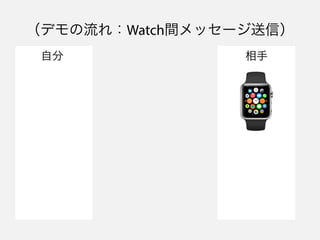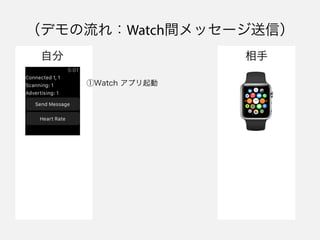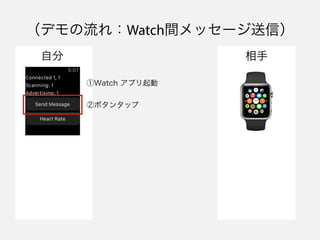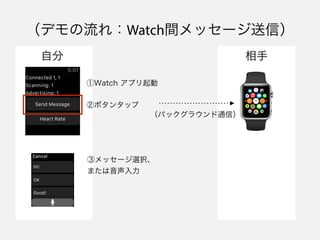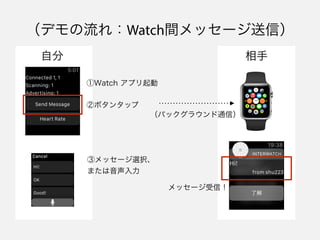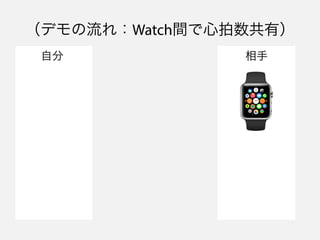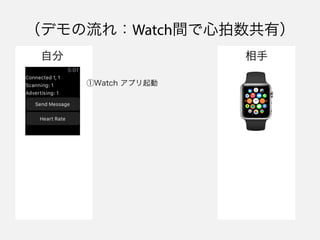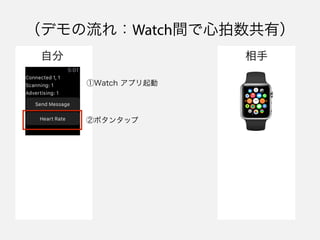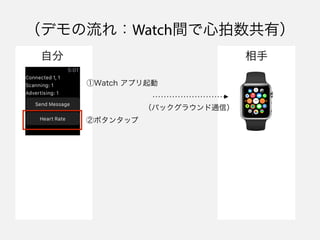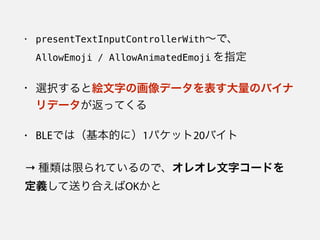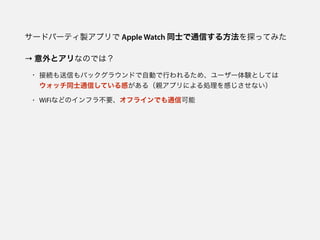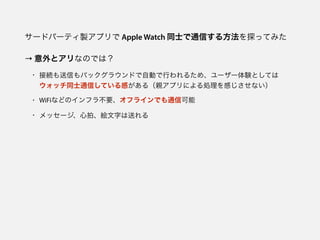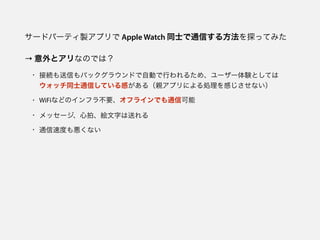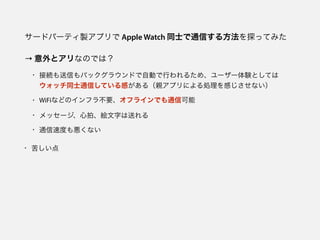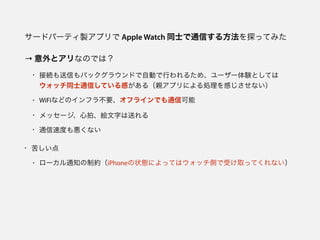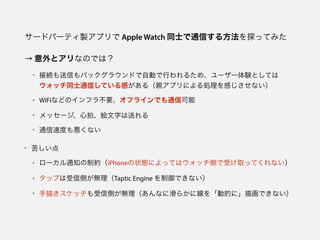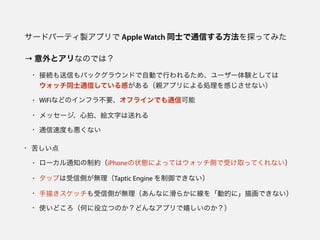Apple Watch 間通信
- 1. Apple Watch 間通信 堤 修一 @shu223 2015.5.27 Apple Watch meetup
- 2. ? 堤 修一(つつみ しゅういち) ? iOS専業フリーランス ? ブログ『Over&Out その後』 ? 著書? 『iOS×BLE?Core Bluetoothプログラミング』? 『iOSアプリ開発 達人のレシピ100』 自己紹介
- 3. お手伝いしたプロダクト(BLE関連) Music for the Deaf
- 5. お手伝いしたプロダクト(奥补迟肠丑碍颈迟関连) WatchMe(Pocket Supernova) ? Watch に最適化されたビデオメッセージングア プリ。ウォッチで動画メッセージのプレビュー、 素早い返信ができる ※お手伝いしたのは開発の初期、ウォッチ側
- 6. お手伝いしたプロダクト(奥补迟肠丑碍颈迟関连) よしだっち(DLE) 鷹の爪団の吉田君を育成するアプリ WatchMe(Pocket Supernova) ? Watch に最適化されたビデオメッセージングア プリ。ウォッチで動画メッセージのプレビュー、 素早い返信ができる ※お手伝いしたのは開発の初期、ウォッチ側
- 7. お手伝いしたプロダクト(奥补迟肠丑碍颈迟関连) よしだっち(DLE) 鷹の爪団の吉田君を育成するアプリ WatchMe(Pocket Supernova) ? Watch に最適化されたビデオメッセージングア プリ。ウォッチで動画メッセージのプレビュー、 素早い返信ができる ※お手伝いしたのは開発の初期、ウォッチ側 メール、Facebookメッセージ、TwitterのDM等を一 元管理するアプリ Swingmail(BHI) ※ウォッチ機能は現在開発中
- 8. 今日话すこと
- 10. 標準で入ってる“Digital Touch”機能 Apple Watch 同士で通信する方法を探る
- 11. 標準で入ってる“Digital Touch”機能 - タップ、心拍、手書きスケッチを相手に送れる Apple Watch 同士で通信する方法を探る
- 12. 標準で入ってる“Digital Touch”機能 - タップ、心拍、手書きスケッチを相手に送れる Apple Watch 同士で通信する方法を探る
- 13. 標準で入ってる“Digital Touch”機能 - タップ、心拍、手書きスケッチを相手に送れる Apple Watch 同士で通信する方法を探る
- 14. 標準で入ってる“Digital Touch”機能 - タップ、心拍、手書きスケッチを相手に送れる WatchKitにそういうAPIはない Apple Watch 同士で通信する方法を探る
- 15. 標準で入ってる“Digital Touch”機能 - タップ、心拍、手書きスケッチを相手に送れる WatchKitにそういうAPIはない → サードパーティ製アプリで同様のことをやるには? Apple Watch 同士で通信する方法を探る
- 16. 案
- 17. この构成で同様のことはできそう
- 23. 通信処理の流れ
- 24. 自分 相手 メッセージを送りたい
- 28. ポイント
- 29. Point 1: Core Bluetooth を用いた通信
- 30. Point 1: Core Bluetooth を用いた通信
- 31. Point 1: Core Bluetooth を用いた通信 ? BLE(Bluetooth Low Energy) を利用
- 32. Point 1: Core Bluetooth を用いた通信 ? BLE(Bluetooth Low Energy) を利用 - WiFi等のインフラなしで通信可能
- 33. Point 1: Core Bluetooth を用いた通信 ? BLE(Bluetooth Low Energy) を利用 - WiFi等のインフラなしで通信可能 ? ステータス確認?スキャン?アドバタイズ? 接続確立?データのやり取り等、ほぼすべて の機能がバックグラウンドで利用可能
- 34. Point 1: Core Bluetooth を用いた通信 ? BLE(Bluetooth Low Energy) を利用 - WiFi等のインフラなしで通信可能 ? ステータス確認?スキャン?アドバタイズ? 接続確立?データのやり取り等、ほぼすべて の機能がバックグラウンドで利用可能 - UX的にはparent appでの処理と悟られない
- 35. Point 1: Core Bluetooth を用いた通信 ? BLE(Bluetooth Low Energy) を利用 - WiFi等のインフラなしで通信可能 ? ステータス確認?スキャン?アドバタイズ? 接続確立?データのやり取り等、ほぼすべて の機能がバックグラウンドで利用可能 - UX的にはparent appでの処理と悟られない - 1度接続すれば、あとは接続が切れても バックグラウンドで勝手に再接続される
- 36. Point 1: Core Bluetooth を用いた通信 ? BLE(Bluetooth Low Energy) を利用 - WiFi等のインフラなしで通信可能 ? ステータス確認?スキャン?アドバタイズ? 接続確立?データのやり取り等、ほぼすべて の機能がバックグラウンドで利用可能 - UX的にはparent appでの処理と悟られない - 1度接続すれば、あとは接続が切れても バックグラウンドで勝手に再接続される - プロセスが死んでてもゾンビのように復活 して繋がってくれる
- 37. Point 1: Core Bluetooth を用いた通信 ? BLE(Bluetooth Low Energy) を利用 - WiFi等のインフラなしで通信可能 ? ステータス確認?スキャン?アドバタイズ? 接続確立?データのやり取り等、ほぼすべて の機能がバックグラウンドで利用可能 - UX的にはparent appでの処理と悟られない - 1度接続すれば、あとは接続が切れても バックグラウンドで勝手に再接続される - プロセスが死んでてもゾンビのように復活 して繋がってくれる ? 詳細はこちら: 『殺しても死なないアプリ』(potatotips #17 での発表)
- 40. Point 2: openParent~による非同期処理実行 ? Core Bluetooth は非同期でレス ポンスが返ってくる処理ばかり
- 41. Point 2: openParent~による非同期処理実行 ? Core Bluetooth は非同期でレス ポンスが返ってくる処理ばかり ? openParent~は親アプリからの レスポンスを受け取れるが、同 期処理なので非同期処理の結果 は受け取れない
- 42. Point 2: openParent~による非同期処理実行 ? Core Bluetooth は非同期でレス ポンスが返ってくる処理ばかり ? openParent~は親アプリからの レスポンスを受け取れるが、同 期処理なので非同期処理の結果 は受け取れない → WatchKit Extension側から結果を受け取れるまでポーリングする - 詳細:『WatchKit もろもろ実機検証』(実装コードあり)
- 43. Point 3: ローカル通知
- 44. Point 3: ローカル通知
- 45. Point 3: ローカル通知 ? openParent~はあるけど openChild 的な础笔滨はない
- 46. Point 3: ローカル通知 ? openParent~はあるけど openChild 的な础笔滨はない → parent app からローカル通知を 発行してウォッチ側で受け取って もらう
- 47. Point 3: ローカル通知 ? openParent~はあるけど openChild 的な础笔滨はない → parent app からローカル通知を 発行してウォッチ側で受け取って もらう ?Watchのローカル通知に対する挙動:? 『WatchKit もろもろ実機検証』(実装コードあり)
- 48. 心拍を送るには?
- 53. HealthKit を利用 心拍を送りたい 自分 相手 ①心拍数計測 (HealthKitに自動保存) ②openParent~ で心拍を送りたい旨だけ伝える ③HealthKit より心拍数取得
- 54. HealthKit を利用 心拍を送りたい 自分 相手 ①心拍数計測 (HealthKitに自動保存) ②openParent~ で心拍を送りたい旨だけ伝える ③HealthKit より心拍数取得 ④バックグラウンドで送信
- 55. HealthKit を利用 心拍を送りたい 自分 相手 ①心拍数計測 (HealthKitに自動保存) ②openParent~ で心拍を送りたい旨だけ伝える ③HealthKit より心拍数取得 ⑤ローカル通知 ④バックグラウンドで送信
- 56. HealthKit を利用 心拍を送りたい 自分 相手 ①心拍数計測 (HealthKitに自動保存) ②openParent~ で心拍を送りたい旨だけ伝える ③HealthKit より心拍数取得 ⑤ローカル通知 心拍数に応じた速さで アニメーションを実行 ④バックグラウンドで送信
- 57. ウォッチで計測した心拍数をリアルタイムに iPhone 側で HealthKit から取得できるのか?
- 58. ウォッチで計測した心拍数をリアルタイムに iPhone 側で HealthKit から取得できるのか? ? 心拍数の単位は“BPM”(Beats Per Minute) なので60秒ぐらい までのタイムラグは許容範囲 かと
- 59. ウォッチで計測した心拍数をリアルタイムに iPhone 側で HealthKit から取得できるのか? ? 心拍数の単位は“BPM”(Beats Per Minute) なので60秒ぐらい までのタイムラグは許容範囲 かと ? ? Watch で心拍数を計測しつ つ、iPhone の Health アプリで 最新データがいつ取得できる か確認してみた
- 60. ウォッチで計測した心拍数をリアルタイムに iPhone 側で HealthKit から取得できるのか? ? 心拍数の単位は“BPM”(Beats Per Minute) なので60秒ぐらい までのタイムラグは許容範囲 かと ? ? Watch で心拍数を計測しつ つ、iPhone の Health アプリで 最新データがいつ取得できる か確認してみた [Health Data] > [Vitals] > [Heart Rate] > [Show All Data]
- 61. ウォッチで計測した心拍数をリアルタイムに iPhone 側で HealthKit から取得できるのか? ? 心拍数の単位は“BPM”(Beats Per Minute) なので60秒ぐらい までのタイムラグは許容範囲 かと ? ? Watch で心拍数を計測しつ つ、iPhone の Health アプリで 最新データがいつ取得できる か確認してみた → ほぼタイムラグなし? ?(多く見ても10秒以内) [Health Data] > [Vitals] > [Heart Rate] > [Show All Data]
- 62. デモ
- 75. ? presentTextInputControllerWith~で、? AllowEmoji / AllowAnimatedEmoji を指定 ? 選択すると絵文字の画像データを表す大量のバイナ リデータが返ってくる ? BLEでは(基本的に)1パケット20バイト → 種類は限られているので、オレオレ文字コードを 定義して送り合えばOKかと
- 76. まとめ?所感
- 77. サードパーティ製アプリで Apple Watch 同士で通信する方法を探ってみた
- 78. サードパーティ製アプリで Apple Watch 同士で通信する方法を探ってみた → 意外とアリなのでは?
- 79. サードパーティ製アプリで Apple Watch 同士で通信する方法を探ってみた → 意外とアリなのでは? ? 接続も送信もバックグラウンドで自動で行われるため、ユーザー体験としては ウォッチ同士通信している感がある(親アプリによる処理を感じさせない)
- 80. サードパーティ製アプリで Apple Watch 同士で通信する方法を探ってみた → 意外とアリなのでは? ? 接続も送信もバックグラウンドで自動で行われるため、ユーザー体験としては ウォッチ同士通信している感がある(親アプリによる処理を感じさせない) ? WiFiなどのインフラ不要、オフラインでも通信可能
- 81. サードパーティ製アプリで Apple Watch 同士で通信する方法を探ってみた → 意外とアリなのでは? ? 接続も送信もバックグラウンドで自動で行われるため、ユーザー体験としては ウォッチ同士通信している感がある(親アプリによる処理を感じさせない) ? WiFiなどのインフラ不要、オフラインでも通信可能 ? メッセージ、心拍、絵文字は送れる
- 82. サードパーティ製アプリで Apple Watch 同士で通信する方法を探ってみた → 意外とアリなのでは? ? 接続も送信もバックグラウンドで自動で行われるため、ユーザー体験としては ウォッチ同士通信している感がある(親アプリによる処理を感じさせない) ? WiFiなどのインフラ不要、オフラインでも通信可能 ? メッセージ、心拍、絵文字は送れる ? 通信速度も悪くない
- 83. サードパーティ製アプリで Apple Watch 同士で通信する方法を探ってみた → 意外とアリなのでは? ? 接続も送信もバックグラウンドで自動で行われるため、ユーザー体験としては ウォッチ同士通信している感がある(親アプリによる処理を感じさせない) ? WiFiなどのインフラ不要、オフラインでも通信可能 ? メッセージ、心拍、絵文字は送れる ? 通信速度も悪くない ? 苦しい点
- 84. サードパーティ製アプリで Apple Watch 同士で通信する方法を探ってみた → 意外とアリなのでは? ? 接続も送信もバックグラウンドで自動で行われるため、ユーザー体験としては ウォッチ同士通信している感がある(親アプリによる処理を感じさせない) ? WiFiなどのインフラ不要、オフラインでも通信可能 ? メッセージ、心拍、絵文字は送れる ? 通信速度も悪くない ? 苦しい点 ? ローカル通知の制約(iPhoneの状態によってはウォッチ側で受け取ってくれない)
- 85. サードパーティ製アプリで Apple Watch 同士で通信する方法を探ってみた → 意外とアリなのでは? ? 接続も送信もバックグラウンドで自動で行われるため、ユーザー体験としては ウォッチ同士通信している感がある(親アプリによる処理を感じさせない) ? WiFiなどのインフラ不要、オフラインでも通信可能 ? メッセージ、心拍、絵文字は送れる ? 通信速度も悪くない ? 苦しい点 ? ローカル通知の制約(iPhoneの状態によってはウォッチ側で受け取ってくれない) ? タップは受信側が無理(Taptic Engine を制御できない)
- 86. サードパーティ製アプリで Apple Watch 同士で通信する方法を探ってみた → 意外とアリなのでは? ? 接続も送信もバックグラウンドで自動で行われるため、ユーザー体験としては ウォッチ同士通信している感がある(親アプリによる処理を感じさせない) ? WiFiなどのインフラ不要、オフラインでも通信可能 ? メッセージ、心拍、絵文字は送れる ? 通信速度も悪くない ? 苦しい点 ? ローカル通知の制約(iPhoneの状態によってはウォッチ側で受け取ってくれない) ? タップは受信側が無理(Taptic Engine を制御できない) ? 手描きスケッチも受信側が無理(あんなに滑らかに線を「動的に」描画できない)
- 87. サードパーティ製アプリで Apple Watch 同士で通信する方法を探ってみた → 意外とアリなのでは? ? 接続も送信もバックグラウンドで自動で行われるため、ユーザー体験としては ウォッチ同士通信している感がある(親アプリによる処理を感じさせない) ? WiFiなどのインフラ不要、オフラインでも通信可能 ? メッセージ、心拍、絵文字は送れる ? 通信速度も悪くない ? 苦しい点 ? ローカル通知の制約(iPhoneの状態によってはウォッチ側で受け取ってくれない) ? タップは受信側が無理(Taptic Engine を制御できない) ? 手描きスケッチも受信側が無理(あんなに滑らかに線を「動的に」描画できない) ? 使いどころ(何に役立つのか?どんなアプリで嬉しいのか?)
- 88. Core Bluetooth / BLE の参考書籍 ? konashi開発者 松村礼央さんとの共著 ? BLEについては知識ゼロからでOKです


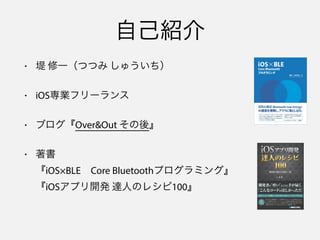
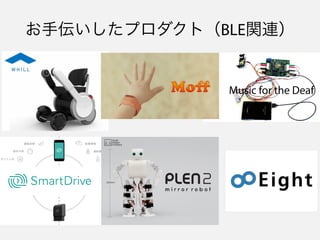


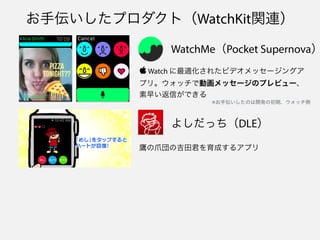
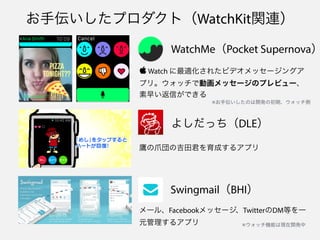

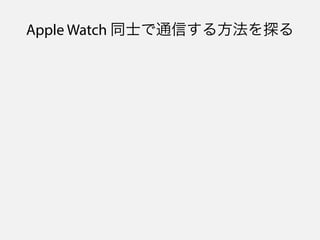


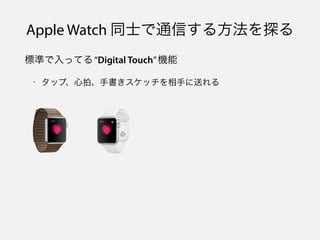
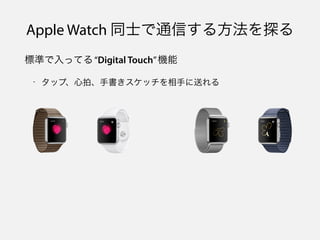




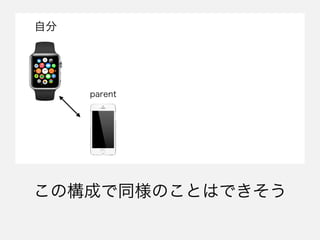
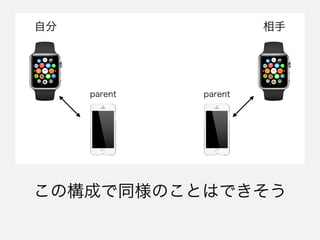
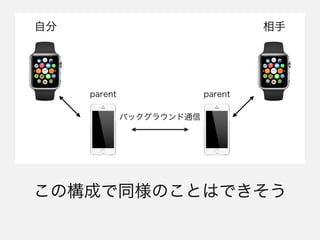
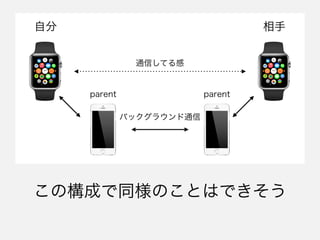
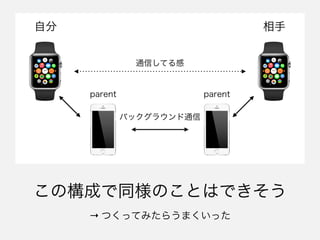






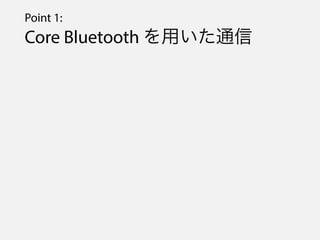

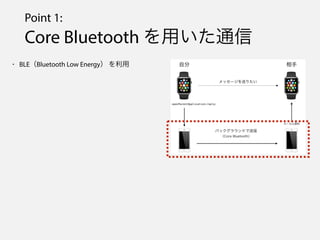


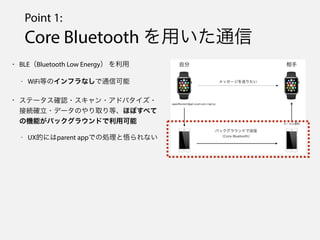
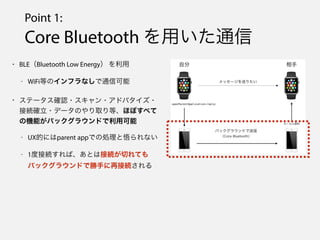



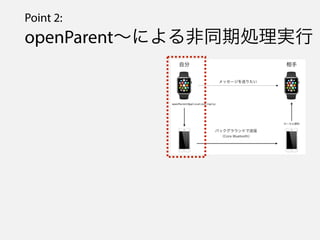
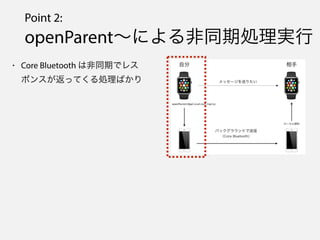
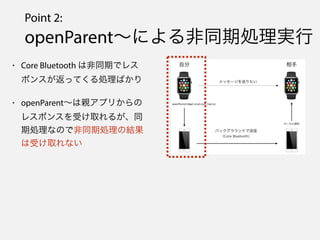
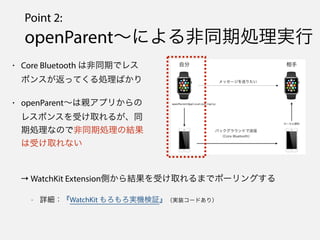

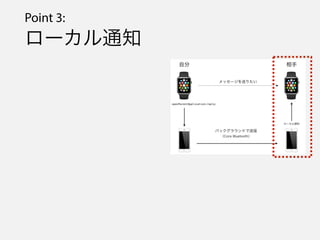
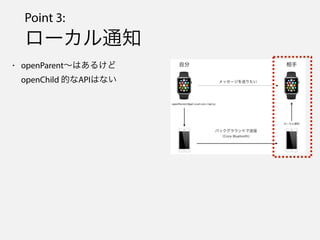



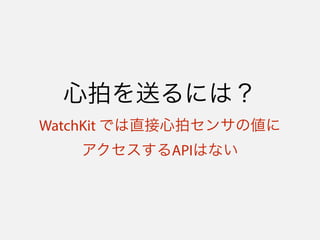
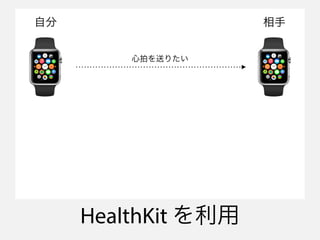
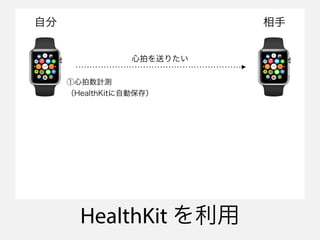
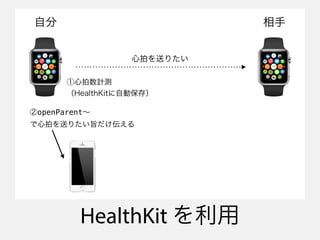


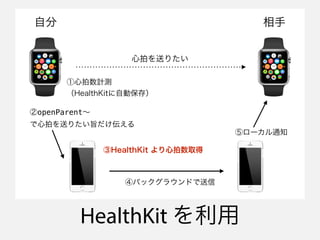
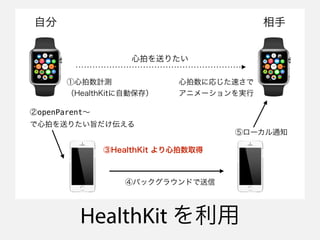



![ウォッチで計測した心拍数をリアルタイムに
iPhone 側で HealthKit から取得できるのか?
? 心拍数の単位は“BPM”(Beats
Per Minute) なので60秒ぐらい
までのタイムラグは許容範囲
かと
? ? Watch で心拍数を計測しつ
つ、iPhone の Health アプリで
最新データがいつ取得できる
か確認してみた
[Health Data] > [Vitals]
> [Heart Rate] > [Show All Data]](https://image.slidesharecdn.com/watchmeetup201505271-150527110306-lva1-app6892/85/Apple-Watch-60-320.jpg)
![ウォッチで計測した心拍数をリアルタイムに
iPhone 側で HealthKit から取得できるのか?
? 心拍数の単位は“BPM”(Beats
Per Minute) なので60秒ぐらい
までのタイムラグは許容範囲
かと
? ? Watch で心拍数を計測しつ
つ、iPhone の Health アプリで
最新データがいつ取得できる
か確認してみた
→ ほぼタイムラグなし?
?(多く見ても10秒以内) [Health Data] > [Vitals]
> [Heart Rate] > [Show All Data]](https://image.slidesharecdn.com/watchmeetup201505271-150527110306-lva1-app6892/85/Apple-Watch-61-320.jpg)

